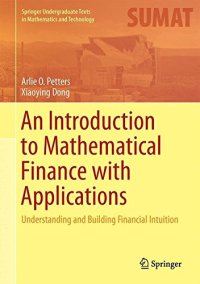
Ebook: An Introduction to Mathematical Finance with Applications: Understanding and Building Financial Intuition
Author: Arlie O. Petters Xiaoying Dong
- Genre: Mathematics
- Tags: Quantitative Finance, Mathematical Modeling and Industrial Mathematics, Probability Theory and Stochastic Processes, Actuarial Sciences
- Series: Springer Undergraduate Texts in Mathematics and Technology
- Year: 2016
- Publisher: Springer
- Edition: 1st ed. 2016
- Language: English
- pdf
Provides a good balance between mathematical derivation and accessibility to the reader and instructor
Self-contained with respect to required finance background, providing financial minutia along the way as needed
Useful for students preparing for high level study in mathematical finance or a career in actuarial science
This textbook aims to fill the gap between those that offer a theoretical treatment without many applications and those that present and apply formulas without appropriately deriving them. The balance achieved will give readers a fundamental understanding of key financial ideas and tools that form the basis for building realistic models, including those that may become proprietary. Numerous carefully chosen examples and exercises reinforce the student’s conceptual understanding and facility with applications. The exercises are divided into conceptual, application-based, and theoretical problems, which probe the material deeper.
The book is aimed toward advanced undergraduates and first-year graduate students who are new to finance or want a more rigorous treatment of the mathematical models used within. While no background in finance is assumed, prerequisite math courses include multivariable calculus, probability, and linear algebra. The authors introduce additional mathematical tools as needed. The entire textbook is appropriate for a single year-long course on introductory mathematical finance. The self-contained design of the text allows for instructor flexibility in topics courses and those focusing on financial derivatives. Moreover, the text is useful for mathematicians, physicists, and engineers who want to learn finance via an approach that builds their financial intuition and is explicit about model building, as well as business school students who want a treatment of finance that is deeper but not overly theoretical.
Topics
Quantitative Finance
Mathematical Modeling and Industrial Mathematics
Probability Theory and Stochastic Processes
Actuarial Sciences
Self-contained with respect to required finance background, providing financial minutia along the way as needed
Useful for students preparing for high level study in mathematical finance or a career in actuarial science
This textbook aims to fill the gap between those that offer a theoretical treatment without many applications and those that present and apply formulas without appropriately deriving them. The balance achieved will give readers a fundamental understanding of key financial ideas and tools that form the basis for building realistic models, including those that may become proprietary. Numerous carefully chosen examples and exercises reinforce the student’s conceptual understanding and facility with applications. The exercises are divided into conceptual, application-based, and theoretical problems, which probe the material deeper.
The book is aimed toward advanced undergraduates and first-year graduate students who are new to finance or want a more rigorous treatment of the mathematical models used within. While no background in finance is assumed, prerequisite math courses include multivariable calculus, probability, and linear algebra. The authors introduce additional mathematical tools as needed. The entire textbook is appropriate for a single year-long course on introductory mathematical finance. The self-contained design of the text allows for instructor flexibility in topics courses and those focusing on financial derivatives. Moreover, the text is useful for mathematicians, physicists, and engineers who want to learn finance via an approach that builds their financial intuition and is explicit about model building, as well as business school students who want a treatment of finance that is deeper but not overly theoretical.
Topics
Quantitative Finance
Mathematical Modeling and Industrial Mathematics
Probability Theory and Stochastic Processes
Actuarial Sciences
Download the book An Introduction to Mathematical Finance with Applications: Understanding and Building Financial Intuition for free or read online
Continue reading on any device:

Last viewed books
Related books
{related-news}
Comments (0)